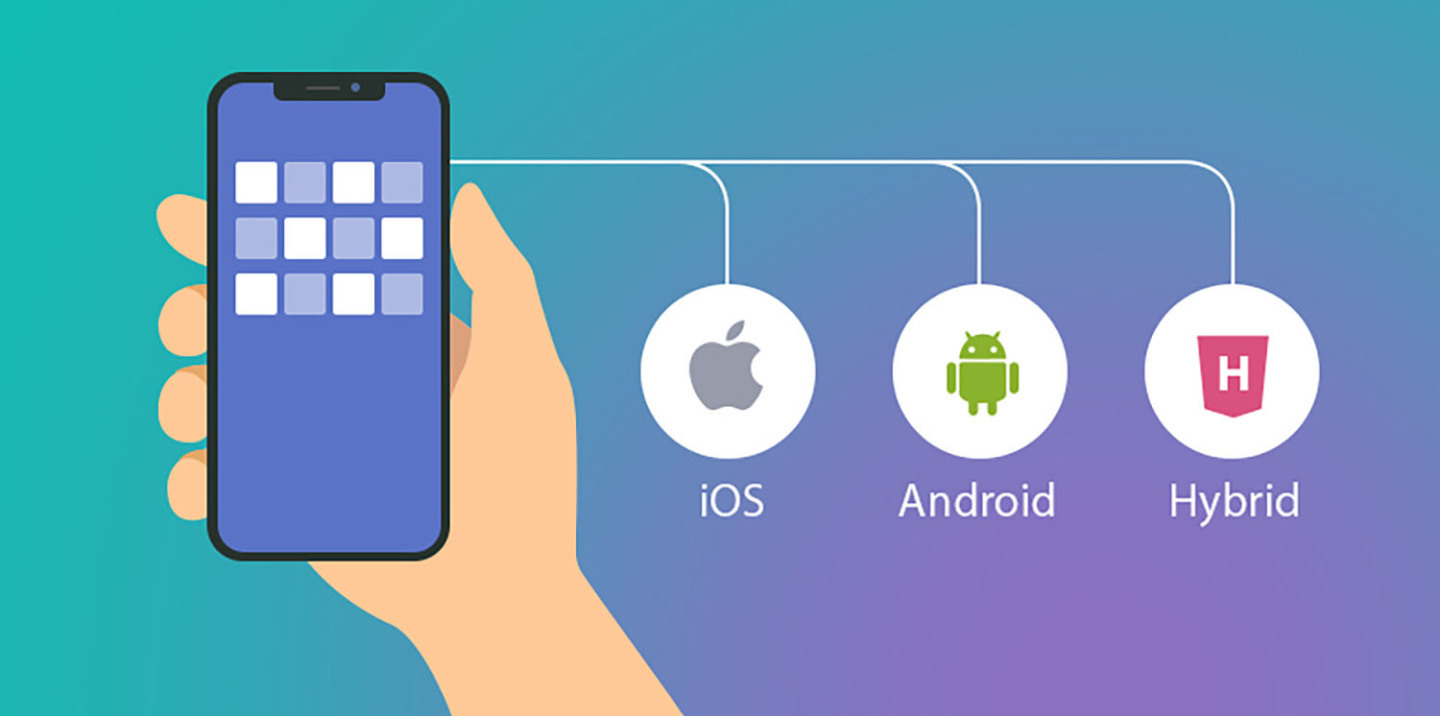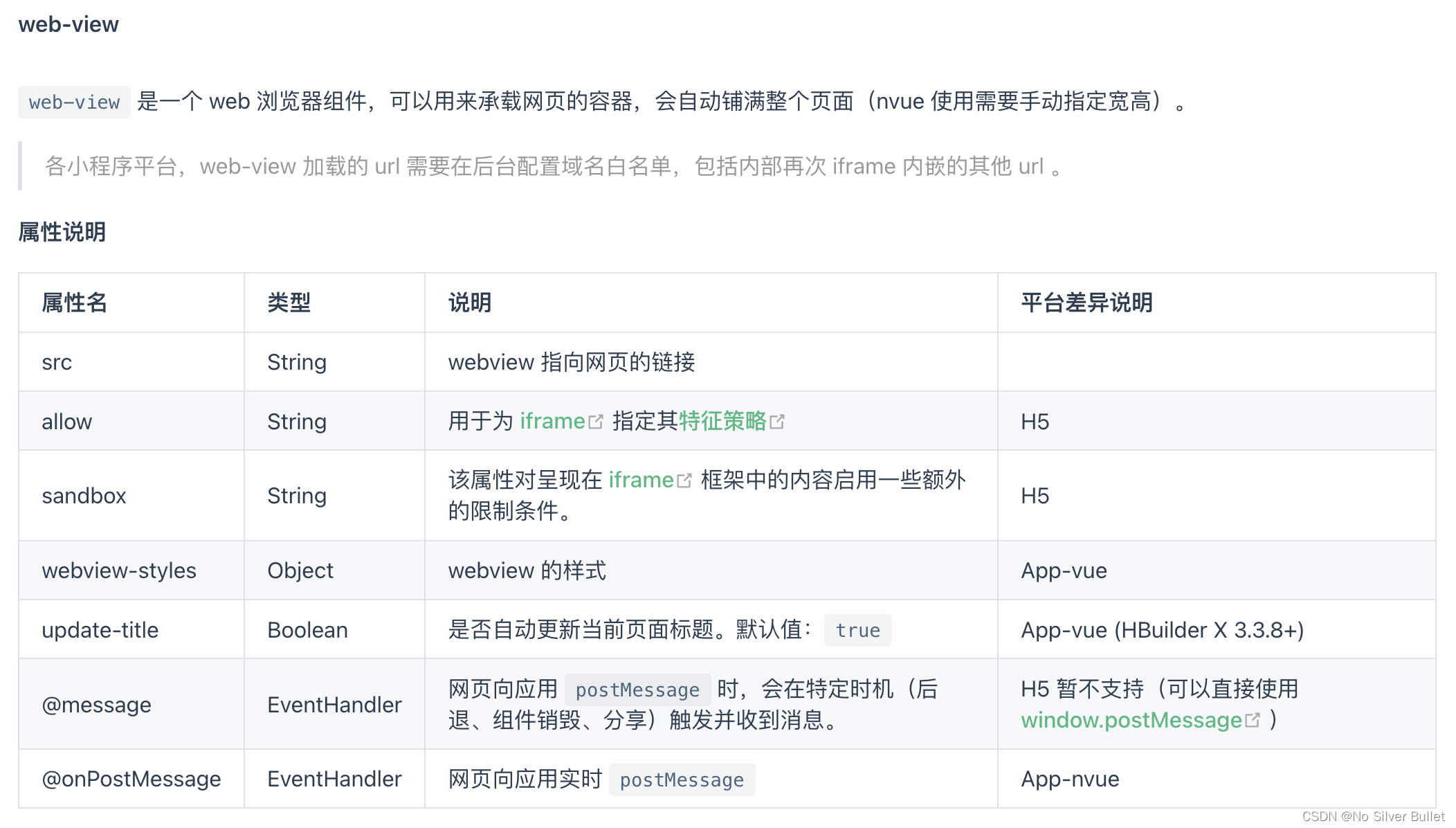一、前言
uni-app应用开发过程中,需要应用内嵌 H5 页面。
现如今,各大 APP 平台都有属于自己的小程序体系,各种各样的应用都可直接内嵌在 APP 中实现一站式体验。使用uniapp开发的 APP 如何实现这样的功能呢?答案就是内嵌web-view。
二、 码上谈兵
📢 注意事项:APP 中有vue页面及nvue页面,两种页面均可内嵌web-view,但两种页面的表现不一:
每个vue页面,其实都是一个webview,而vue页面里的web-view组件,其实是webview里的一个子webview。这个子webview被 append 到父webview上。
vue页面会自动铺满整个页面,接收web-view页面通信使用的是@message;
nvue页面则需要指定页面宽高,接收web-view页面通信使用的是@onPostMessage;
app-vue下web-view组件不支持自定义样式,而v-show的本质是改变组件的样式。即组件支持v-if而不是支持v-show。
<web-view> 组件默认铺满全屏并且层级高于前端组件。App 端想调节大小或在其上覆盖内容需使用 plus 规范。
H5端的web-view其实是被转为iframe运行,使用的是当前的浏览器;
App端,iOS,是分为UIWebview和WKWebview的,2.2.5+起默认为WKWebview;
nvue web-view 必须指定样式宽高;
App 网页向应用 postMessage 为实时消息;
app-nvue web-view 默认没有大小,可以通过样式设置大小,如果想充满整个窗口,设置 flex: 1 即可,标题栏不会自动显示 web-view 页面中的 title。如果想充满整个窗口且想要显示标题推荐使用 vue 页面的 web-view(默认充满屏幕不可控制大小), 想自定义 web-view 大小使用 nvue web-view;
由APP通知web-view页面,无论是vue页面还是nvue页面,只有evalJS方法,但调用姿势不一致。
vue 页面调用:
<template> <web-view :src="url" @message="message" :webview-styles="webviewStyles" @onPostMessage="handlePostMessage"></web-view> <button class="button" @click="evalJs">evalJs(改变webview背景颜色)</button></template>...<script>export default { data() { return { webviewStyles: { progress: { color: '#FF3333' } } } } onLoad() { this.currentWebview = this.$mp.page.$getAppWebview(); this.currentWebview.children()[0].evalJS('xxx'); }, methods: { // webview向外部发送消息,APP接收并处理 handlePostMessage: function(data) { console.log("接收到消息:" + JSON.stringify(data.detail)); }, // 调用 webview 内部逻辑 evalJs: function() { this.$refs.webview.evalJs("document.body.style.background ='#00FF00'"); } }}</script>
复制代码
nvue 页面调用:
<template> <web-view ref="webview" :src="url" @message="message"></web-view></template>...<script>export default { xxx, onReady() { this.currentWebview = this.$refs.webview; this.currentWebview.evalJS('xxx'); }}</script>
复制代码
nvue页面中使用的web-view页面是无法调用plus API的,vue页面是可以控制外部web-view页面是否可用plus API,其他事项具体参考web-view | uni-app官网。
三、适配问题剖析
Android、iOS平台顶部导航栏的表现不一:因内嵌web-view应用需要全屏显示,标题栏也交由内嵌应用自定义,故在pages.json中定义页面的时候,须将页面的titleNView设置为false。但即便如此,其表现仍然不一致,表现为Android端的页面起始位置是手机屏幕的最顶部(含状态栏在内),iOS端则是从状态栏之下开始渲染页面,为了抹平差异,可使用webview的setStyle统一样式。
APP 端设置:
export default { onReady() { this.currentWebview = this.$mp.page.$getAppWebview(); // 提前计算好屏幕比率(screenRatio),底部安全距离(safeAreaInsetsBtm),区分平台(platform) let { screenRatio, safeAreaInsetsBtm, platform } = this.$store.state; // 由于iOS端会自动定位top到状态栏底下,故这里需要判断手机系统 // 因调节Android端的top值能看出头部变化,故转换思路调ios端的top值 let top = 0; if (platform === 'ios') { let info = uni.getSystemInfoSync(); top = -info.statusBarHeight; } let bottom = safeAreaInsetsBtm / screenRatio; this.currentWebview.children()[0].setStyle({ top, bottom: parseInt(bottom) }); }}
复制代码
统一两端的top至手机屏幕最顶部,bottom至手机屏幕安全距离之上。
内嵌应用中设置:
// 内嵌应用中,配置一个全局变量管理顶部样式,比如可在vuex的action中写个setPage方法const actions = { setPage(context) { let statusbarHeight = plus.navigator.getStatusbarHeight(); let pageStyle = { paddingTop: `calc(0.2rem + ${statusbarHeight}px)` }; context.commit('pageStyle', pageStyle); }};
复制代码
内嵌应用中的数据传递:由 APP 中调用evalJS方法,调用到的是内嵌应用index.html中定义的方法,怎么将 APP 传递过来的信息传递到内嵌应用的vue页面去呢?这里推荐一个插件mitt。
APP 中调用:
export default { onReady() { this.currentWebview = this.$mp.page.$getAppWebview(); this.currentWebview.children()[0].evalJS("showTip('提示测试')"); }}
复制代码
内嵌应用的 index.html 中,引用下载到本地的mitt.umd.js:
<!DOCTYPE html><html lang="en"> <head> <meta charset="utf-8" /> <meta http-equiv="X-UA-Compatible" content="IE=edge" /> <meta name="renderer" content="webkit" /> <meta name="viewport" content="width=device-width, user-scalable=no, initial-scale=1.0, maximum-scale=1.0, minimum-scale=1.0" /> <!-- uni 的 SDK,必须引用。 --> <script src="<%= BASE_URL %>libs/uni-app/uni.app.webview.1.5.2.js"></script> <!--html页面与vue页面通讯js--> <script src="<%= BASE_URL %>libs/mitt/mitt.umd.js"></script> <title>xxx</title> </head>
<body> <noscript> <strong>当前浏览器版本太低,请升级浏览器或使用其他浏览器</strong> </noscript> <div id="app"></div> <!-- built files will be auto injected --> <script> window.bus = window.mitt(); const showTip = (tip) => { window.bus.emit('showTip', tip); }; </script> </body></html>
复制代码
内嵌应用 vue 页面中:
export default { activated() { // 挂载 window.bus.on('showTip', (tip) => { alert(tip); }); } deactivated() { // 离开时记得销毁 window.bus.off('showTip'); }}
复制代码
四、拓展阅读













评论